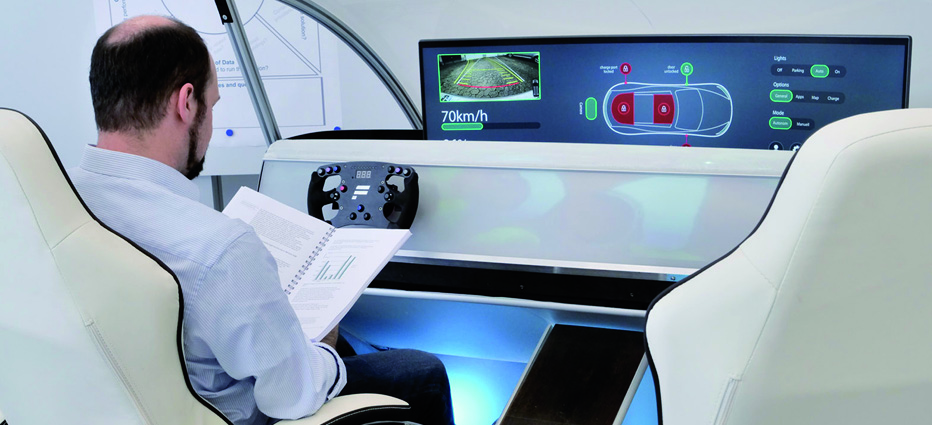
Cars of the future will be much more than simply modes of transportation, gradually evolving to become “homes away from home” – places for people to work or unwind in a new age of autonomous driving.
In a newly founded innovation network, researchers from the Fraunhofer Institute for Industrial Engineering IAO have joined forces with McKinsey & Company and a range of industry project partners to collaborate on the mobility solutions of tomorrow – from conceptual idea to finished prototype.
Cars of the future will be fully automated, transforming drivers into passengers – people who are no longer occupied with paying attention to the road, and who may have the desire or even the need to divert themselves with other activities. With vehicles steering, accelerating and braking entirely by themselves, drivers are freed up to admire their surroundings in a whole new way through the windshield display, or simply dim the windows and settle back to watch a movie. The car’s interior has been transformed into an office or living room. Sebastian Stegmüller, researcher at Fraunhofer IAO, is familiar with the scenarios and believes they could become a reality in just a few years. Together with his team, his job is to look at the various ideas that are emerging, and determine as quickly as possible which technologies, services and business models could catch on and which of them are unlikely to succeed in the marketplace.
An automotive industry in flux
To conduct their research, Stegmüller and his colleagues have joined forces with management consultancy McKinsey & Company. Through the Mobility, Experience and Technology Lab, or MXT for short, the two partners are establishing a network that endeavors to bring the future of autonomous driving to life. This includes analyzing trends to support businesses in making decisions on innovation projects. “Our job is to pick out the most promising ideas at the beginning of the innovation lifecycle, even before product development has begun,” explains Stegmüller. In that way, the collaboration partners are doing their part to respond to the overwhelming wave of potential new innovations presented by the next big trends in the automotive industry: automation, vehicle connectivity and electrification, as well as new mobility services. “Business will have to reposition itself to respond to the digital transformation, but this also offers the opportunity for whole new mobility services and driving experiences,” says Stegmüller, who heads the Mobility Innovation department. One solution, for instance, envisages voice-assisted services that draw on artificial intelligence, with car windshields turning into multifunctional displays. “Imagine, for instance, that the ticketing service popped up on the display while you were driving past the opera house. You’d be able to book your Aida tickets while you were driving by,” says Dr. Tobias Schneiderbauer, Project Manager at McKinsey & Company.
Bringing the future of mobility to life
At the heart of this initiative to pursue the most promising ideas is Fraunhofer IAO’s Mobility Innovation Lab in Stuttgart. This modern research facility for prototyping and creative workshops already provides an insight into the mobility of tomorrow, featuring, for instance, a converted vehicle that interacts with pedestrians; an electric three-wheel scooter that hints at the future of sustainable inner-city mobility; and a futuristic car cockpit complete with modular dashboard, windows made of switchable glass, reclining seats, fold-out tables and a pull-out monitor – a glimpse into the cockpit of the future and how it might interact with future on-board electronics and services such as language learning, pizza delivery or personalized entertainment.
Through their research, the partners in the innovation network are creating a founded basis for lucrative business models and technologies. This targets not only automotive manufacturers and suppliers, but companies from the entertainment and IT sectors as well. The partners have also taken care to bring on board businesses, municipalities and other stakeholders who support and enrich the network with their particular expertise. The network remains open to any companies wishing to be involved with the MXT Lab.
Study into the mobility of tomorrow
One of the key roles of the MXT Lab is to carry out user studies, providing a first indicator of the viability of potential innovation opportunities. In one of the first such studies, the partners investigated whether the time freed up by autonomous driving might be suited to language learning. On top of a quantitative online survey conducted in Germany, China and the U.S., the researchers also set up an experiment at the lab to gather qualitative user feedback. The goal was to assess the underlying demand for these sorts of services as well as the attractiveness of various technical solutions and driving-related applications. This information allows the researchers to draw conclusions that can then be fed into the automation of the driving experience in the future and the way that these vehicles are designed.